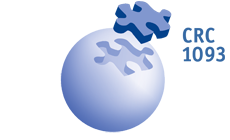CRC 1093 - Publications Project B3
Area B: Biological Targets
Publications by Prof. Dr. Herbert de Groot and Prof. Dr. Michael Kirsch
Project B3:
Supramolecular specific inhibitors of intestinal proteases against ischemia/reperfusion injury
A. Scheer, M. Kirsch, R. Verhaegh, M. Kirsch: Survivin expression pattern in the intestine of normoxic and ischemic rats. BMC Gastroenterology 2017 Jun. 14. DOI: 10.1186/s12876-017-0625-6
P. Gilles, K. Wenck, I. Stratmann, M. Kirsch , D. A. Smolin, T. Schaller, H. de Groot, A. Kraft, T. Schrader: High-Affinity Copolymers Inhibit Digestive Enzymes by Surface Recognition. Biomacromolecules. 2017 Jun 12;18(6):1772-1784. doi: 10.1021/acs.biomac.7b00162. Epub 2017 May 9
M. Walensi, H. de Groot, R. Schulz, M. Hartmann, F. Petrat: Mesenteric ischemia-reperfusion injury: Clearly improved hemodynamics but only minor protection of the rat small intestine by (sub)therapeutic heparin sodium and enoxaparin doses. J. Surg. Res. 2013, 179, e57-e69.
R. Rohrig, T. Rönn, S. Lendemans, T. Feldkamp, H. de Groot, F. Petrat: Adverse effects of resuscitation with lactated ringer compared with ringer solution after severe hemorrhagic shock in rats. Shock 2012, 38, 137-145.
T. Rönn, S. Lendemans, H. de Groot, F. Petrat : A new model of severe hemorrhagic shock in rats. Comp. Med. 2011, 61, 419-426.
F. Petrat, J. Drowatzky, K. Boengler, B. Finckh, K. J. Schmitz, R. Schulz, H. de Groot: Protection from glycine at low doses in ischemia-reperfusion injury of the rat small intestine. Eur. Surg. Res. 2011, 46, 180-187.
F. Petrat, H. de Groot : Protection against severe intestinal ischemia/reperfusion injury in rats by intravenous resveratrol. J. Surg. Res. 2011, 167, e145-e155.
F. Petrat, T. Rönn, H. de Groot : Protection by pyruvate infusion in a rat model of severe intestinal ischemia-reperfusion injury. J. Surg. Res. 2011, 167, e93-e101.
F. Petrat, S. Swoboda, H. de Groot, K. J. Schmitz: Quantification of ischemia-reperfusion injury to the small intestine using a macroscopic score. J. Invest. Surg. 2010, 23, 208-217.
F.-G. Klärner, T. Schrader, J. Polkowska, F. Bastkowski, P. Talbiersky, M. Campañá Kuchenbrandt, T. Schaller, H. de Groot, M. Kirsch: Effect of molecular clips and tweezers on enzymatic reactions by binding coenzymes and basic amino acids. Pure Appl. Chem. 2010, 82, 991-999.
M. Kirsch, P. Talbiersky, J. Polkowska, F. Bastkowski, T. Schaller, H. de Groot, F. Klärner, T. Schrader: A mechanism of efficient G6PD inhibition by a molecular clip. Angew. Chem. Int. Ed. Engl. 2009, 48, 2886-2890.
F. Petrat, S. Paluch, E. Dogruöz, P. Dörfler, M. Kirsch, H.-G. Korth, R. Sustmann, H. de Groot: Reduction of iron(III) ions complexed to physiological ligands by lipoyl dehydrogenase and other flavoenzymes in vitro. Implications for an enzymatic reduction of Fe(III) ions of the labile iron pool. J. Biol. Chem. 2003, 278, 46403-46413.
More Publications Area B
- Project B1
Supramolecular ligands modulate assembly and function of HtrA proteases (Michael Ehrmann) - Project B2
Probing mechanisms of the Cdc48/p97 segregase with designed supramolecular ligands (Hemmo Meyer) - Project B3
- Project B4
Modulation of 14-3-3 protein-protein interactions by supramolecular chemistry (Christian Ottmann) - Project B5
Dissection and modulation of (patho)biological Survivin functions by supramolecular ligands (Shirley Knauer) - Project B6
Targeting centromer recruitment of mitotic regulators by supramolecular ligands (Andrea Musacchio)


